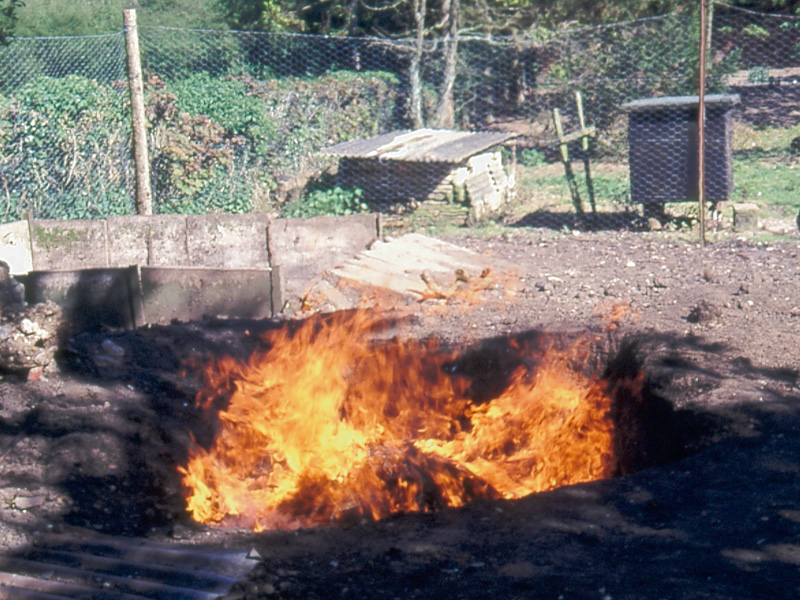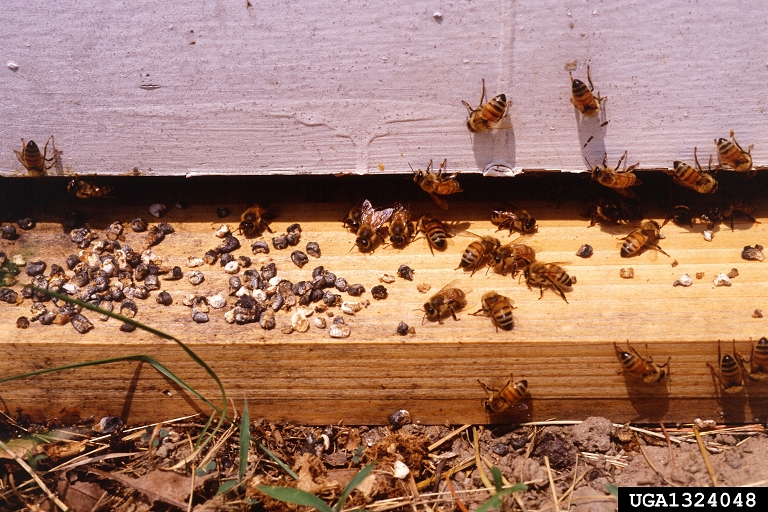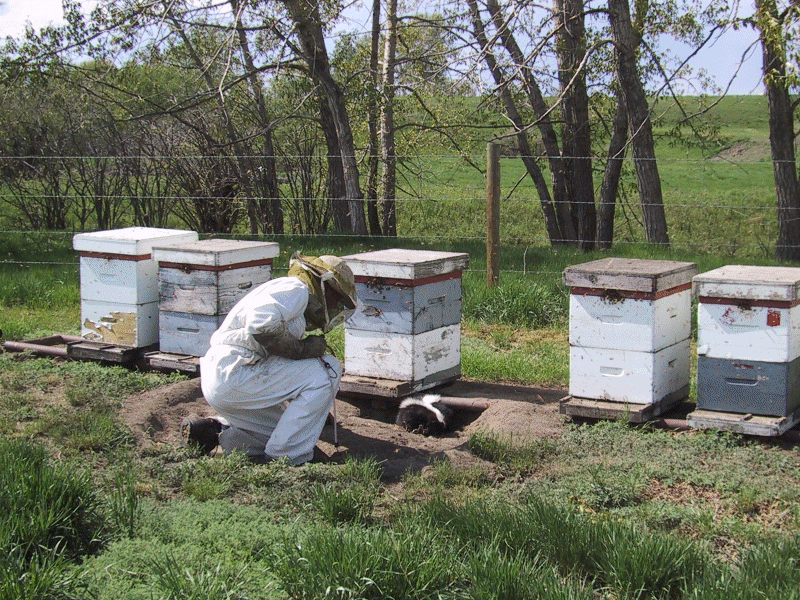Diseases, parasites,
and other pests |
In
current times, honey bees require our diligent care &
attention.
Long gone are the days you could set up a colony and walk away. Today,
there are many stressors on honey bee colonies - lack of good year
round foraging, bad location for apiary, bad beekeeping, etc. Disease
& pests are just one small part of the problem - The #1
stressor -
Varroa Destructor (parasite) will be covered under our next
lesson, but right now I'm speaking on different diseases and
pests
you could find in your hives, and what you can do to help your bees. |
|
|
| Buying used equipment unwise unless it has been
properly examined for diseases. |
Always
best for beginning beekeepers to start with new equipment, but if
buying used equipment you can cut out a sample of the brood comb and
send to a bee disease lab to be tested. Cut out 4" square from center
of the brood area, wrap in newspaper then plastic bag, Pack
in cardboard box & mail to: Beneficial Insect
Lab, Bldg.
476 Beltsville Agricultural Research Center Bee research Entomologist
Room 211 10300 Baltimore Ave. BLDG 476 BARC-EAST Beltsville, MD 20705
put your return address inside and outside of pkg.
|
|
|
Observations: Use your senses - eyes, ears & nose... |
Healthy
looking broodcomb:
  |
|
|
|
Bacterial
Diseases |
American Foulbrood
(ropey dead larvae, black scales, dark sunken cappings, distinct foul
offensive odor) |
This is a condition of hives caused by a spore
forming bacteria called (Paenibacillus larvae).
Bee larvae consume the spores which then germinate in the gut and
multiply in the tissues. Infected larvae usually die once the
cell is sealed. It can be spread by robbing bees, using infected
equipment and hives, and from even catching infected swarms.
Prevention? Keep large healthy colonies, destroy contaminated
equipment/hives. Medication? Terramycin? Terra-Pro? Tylosin? Tylan?
Spores last for 50 years and indestructable.
   To avoid AFB some beekeepers will
routinely treat with antibiotics like Terramycin and Tylosin. However,
we must all keep in mind that routine treatments with antibiotics will
eventually result in antibiotic resistant bacteria and unnatural often
toxic residues in honey combs. The best ways to naturally prevent AFB
is to never buy used equipment and keep a hygienic hive.
To avoid AFB some beekeepers will
routinely treat with antibiotics like Terramycin and Tylosin. However,
we must all keep in mind that routine treatments with antibiotics will
eventually result in antibiotic resistant bacteria and unnatural often
toxic residues in honey combs. The best ways to naturally prevent AFB
is to never buy used equipment and keep a hygienic hive. |
|
|
European Foulbrood
(uncapped dying yellow- brown brood, sour smell, not stringy) |
European
Foulbrood is similar to American Foulbrood as it is a bacteria (Melissococcus
pluton) that attacks brood cells. However, EFB is not nearly
as detrimental. The remedy for EFB is not as extreme as burning your
hives in fact, a healthy hive can at times fend off EFB. Antibiotics
like Terramycin can be used to prevent EFB. In a weak hive you may want
to add frames of uncapped healthy larvae from a stronger hive to
attract attention from nurse bees keeping them away from diseased
larvae. The characteristics of European Foulbrood include brood dying
uncapped, spotty brood pattern, sunken and punctured brood cappings,
brood color turns from white to a yellow-brown, brood emits a sour
smell, and cells will not possess the stringy texture as that of
American Foulbrood.
  |
|
|
|
Fungal
Diseases |
Chalkbrood
(mummified, chalk white larvae/pupae on the porch)
|
Chalkbrood,
a fungal disease of the honey bee larvae & pupae associated
with low temperature and moisture stress conditions. Symptoms usually
disappear with Summer - House bees are able to remove the dead larvae
from their cells. (Stonebrood
is another fungal disease looking similar in appearance but mummified
larvae are hard to crush)

|
|
|
|
Viral
Diseases |
Sacbrood - SBV
(blotted larvae turn gray then black, jagged capping opening, can be
removed whole by toothpick) |
Sacbrood is caused by a virus (Morator
Aetatulas), less destructive and less contagious then
foulbrood. Can be a problem if colony short on nurse bees. It seldom
becomes serious. Requeen if it persists.
  |
|
|
|
Environmental
Causes |
Chilled Brood
|
Brood
dies from neglect, not enough nurse bees to feed & cover (keep
warm). Keep brood combs together, inspect on warm days & return
brood combs quickly during inspection. I remove brood frames
from hive for inpection only if temp. 60 degrees or higher.

|
|
|
|
Fungi
Parasites |
Nosema A, Nosema C
(fecal spotting) |
Nosema
Apis & Nosema Ceranae... Nosema C (fungi)
seems to be the prevelant strain and most destructive at this time.
Attacks the inner lining of the bee's mid-gut. Treatment is an
antibiotic - Fumigilin-B (Fumidil-B no longer available).
Feeding of the anti-biotic in sugar syrup may not be as
effective
against Nosema C. but Fumigilin-B added to a sugar syrup
drench
over 4 week period to encourage flushing of bee stomach/intestines is
said to be more effective against Nosema C. (Nosema ceranae
is a microsporidian, a small, spore forming unicellular parasite. They
were once thought to be protists but are now known to be fungi. )

Good accurate information from Eric
Mussen U.C. Davis: http://entomology.ucdavis.edu/files/147621.pdf
|
|
|
|
Paralysis
Virus
|
Paralysis
is a virus disease that has not caused much loss in the Northern
States. It affects adult bees, appear to be partially paralyzed,
tremble, look old, shiny, greasy... disease seems to be present in only
onbred or non-resistant strains of bees, re-queen the colony. (Acute,
Chronic, Israeli, Kashmir - all Paralysis Virus') |
|
|
| Other Virus' |
Black
Queen Cell Virus, Cloudy Wing Virus, Deformed Wing Virus, Kakugo Virus,
Tobacco Ringspot Virus
(opportunistic - most are related Varroa Destructor
infestations) |
|
|
| Dysentery |
Dysentery
is a condition not a disease. Caused by poor quality winter stores or
prolonged confinement during winter months. Also caused by Nosema A or
Nosema C. |
|
|
| Poisoning |
Lots
of dead bees on the door-step or in front of the hive? an
organophosphate smell? Prevention: move your bees before spraying takes
place. Report the incident to:
Washington State Department of Agriculture
Pesticide Management Division
877-301-4555 (toll free)
compliance@agr.wa.gov
Good resource online for prevention info:
http://www.step-project.net/NPDOCS/PNW%20591.pdf |
|
|
|
Pests of Honey Bees |
Wax Moths |
Wax
moths are a prominent enemy of bees, but they render a service when
they destroy neglected combs on which bees have dies of American
Foulbrood. Two types - Greater & lesser moth. Moths do not kill
bees but destroy combs not properly protected. The best way to protect
combs is to give them back to the care of the bees by placing them over
strong colonies.
 
To
protect supers or any comb not placed on the hives, stack in airtight
pile, fumigate with PDB (Paradichlorobenzene, follow label
instructions. NEVER treat with moth balls (naptha based products). |
|
|
Small Hive Beetle |
Adult
beetles usually gather at the rear of the hive where they gather on the
bottom board.
|
|
|
Yellow Jackets, Ants, and Earwigs |
Strong
colonies usually repel such insect invaders. Entrances can be reduced
to assist the bees in defending the colony against aggressive yellow
jackets in August & September. Still the best defense is a
strong healthy colony.
 |
|
|
Mice |
Mice
can be very destructive to hives in winter and should be
excluded
from the hive. Keep mice out of the honey supers stored also.
  |
|
|
Skunks/Racoons/etc. |
Evidence
of packed dirt at the entrance and muddy bottom board or feces with bee
bodies in it?
  |
|
|
Bears? |
Total
destruction! electric fence? move apiary? shoot the bears?
 
|
|
|
Birds |
Could
be problem for queen rearing apiaries? Otherwise, small amount of
foragers lost
 |
|
|
|
Questions? |


















